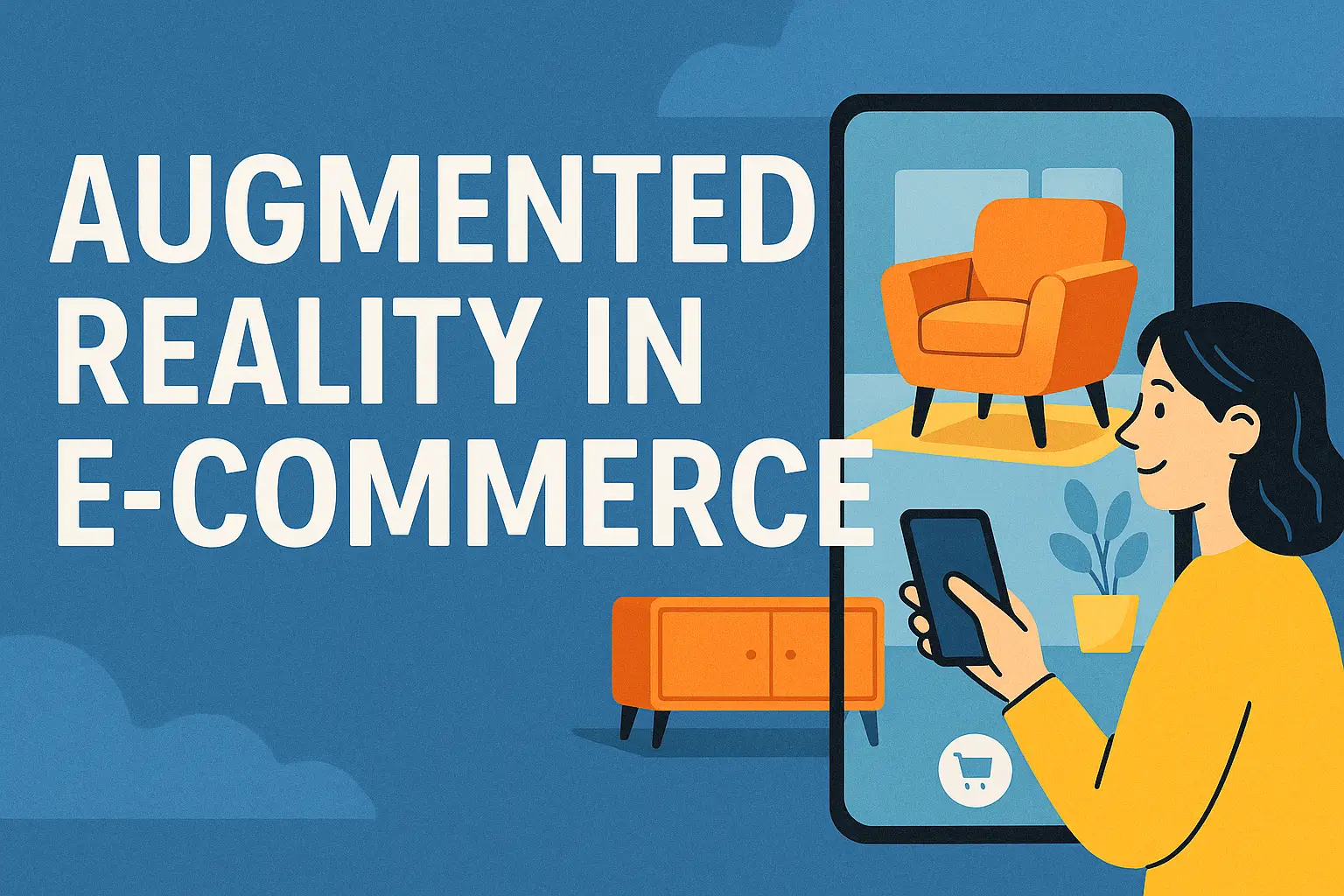
I. Introduction to Augmented Reality in E-commerce
Augmented Reality (AR) is revolutionizing the way consumers interact with products and brands in the digital marketplace. By superimposing digital information—such as images, sounds, and other sensory enhancements—onto the physical world, AR creates an immersive shopping experience that bridges the gap between online and offline retail. This technology allows customers to visualize products in their own environment, ultimately empowering them to make more informed purchasing decisions.
A. Definition of Augmented Reality (AR)
At its core, Augmented Reality is a technology that overlays digital content onto the real world, enhancing the user’s perception and interaction with their surroundings. Unlike Virtual Reality (VR), which creates an entirely immersive experience in a virtual environment, AR enriches the real world by adding layers of digital information. This can range from simple overlays, such as product labels and reviews, to complex 3D models that allow for interactive exploration of items. In the context of e-commerce, AR transforms how products are showcased and experienced, creating a more engaging and informative shopping journey.
B. The Evolution of AR Technology
The roots of Augmented Reality can be traced back to the 1960s, with early developments focusing primarily on military and scientific applications. However, in recent years, the technology has advanced dramatically, driven by improvements in hardware, software, and mobile connectivity. The proliferation of smartphones equipped with advanced cameras and sensors has made AR more accessible to consumers and businesses alike. Major tech companies have invested heavily in AR development, leading to user-friendly platforms and applications that enable e-commerce brands to incorporate AR features seamlessly into their shopping experiences. This evolution has not only enhanced the functionality of AR but has also broadened its appeal to a wider audience.
C. Importance of AR in the Digital Shopping Experience
In an increasingly competitive e-commerce landscape, brands are constantly seeking innovative ways to capture consumer attention and enhance engagement. Augmented Reality offers a unique solution by providing customers with a more interactive and personalized shopping experience. By allowing users to visualize how products will look and fit in their own spaces, AR reduces uncertainty and enhances confidence in purchasing decisions. Furthermore, AR can foster a deeper emotional connection between consumers and brands, as it transforms the passive act of browsing into an engaging experience. As such, integrating AR into e-commerce design not only meets the evolving expectations of consumers but also positions brands at the forefront of technological innovation in the retail space.
II. Enhancing Customer Engagement through AR
As the e-commerce landscape continues to evolve, businesses are increasingly turning to Augmented Reality (AR) as a tool to enhance customer engagement. This technology not only enriches the shopping experience but also fosters a deeper connection between brands and their customers. In this section, we will explore three pivotal aspects of how AR can transform customer engagement: interactive product visualization, personalized marketing strategies, and gamification.
A. Interactive Product Visualization
One of the most compelling applications of AR in e-commerce is its ability to provide interactive product visualization. Traditional online shopping often leaves customers questioning how a product will fit into their lives. AR addresses this concern by allowing customers to visualize products in their own environment before making a purchase. For instance, furniture retailers can offer AR features that enable users to see how a sofa would look in their living room, or fashion brands can allow customers to try on clothes virtually.
This interactive experience not only helps customers make informed decisions but also reduces return rates, as the likelihood of mismatch decreases when customers can see the product in context. Moreover, such immersive experiences can lead to higher conversion rates, as customers feel more confident in their purchases.
B. Personalized Marketing Strategies
AR also opens the door to personalized marketing strategies that resonate with the unique preferences of individual consumers. Through AR experiences, brands can create tailored content that speaks directly to the interests and needs of their target audience. For example, beauty retailers can offer AR applications that allow users to see how different shades of makeup look on their skin tone, effectively personalizing the shopping experience.
Additionally, AR can facilitate targeted promotions based on user behavior and preferences. By analyzing how customers interact with AR features, brands can gain valuable insights into their preferences and tailor marketing messages accordingly. This level of personalization not only enhances customer satisfaction but also fosters brand loyalty, as consumers feel valued and understood.
C. Gamification and AR Experiences
Incorporating gamification into AR experiences is another powerful way to boost customer engagement. By adding game-like elements, such as challenges, rewards, and interactive storytelling, brands can create memorable and enjoyable shopping experiences. For instance, a clothing retailer might develop an AR scavenger hunt where customers search for virtual items within their physical stores or online platforms, earning discounts or loyalty points along the way.
Gamification encourages customers to spend more time engaging with the brand, thus increasing their likelihood of making a purchase. It also creates a sense of community among users, as they may compete with friends or share their experiences on social media, further amplifying brand visibility.
In summary, Augmented Reality presents a myriad of opportunities to enhance customer engagement in e-commerce. By leveraging interactive product visualization, personalized marketing strategies, and gamification, brands can create dynamic shopping experiences that not only captivate consumers but also drive sales and foster long-term loyalty. As AR technology continues to advance, its potential to transform the e-commerce landscape will only grow, paving the way for even more innovative customer engagement strategies.
III. Technical Considerations for Implementing AR
As businesses increasingly recognize the potential of augmented reality (AR) to enhance customer experiences, it is crucial to understand the technical considerations involved in implementing AR effectively within e-commerce platforms. This section delves into key elements that organizations must address to successfully integrate AR technology into their online shopping environments.
A. Choosing the Right AR Platform
The first step in implementing AR in e-commerce is selecting a suitable platform that aligns with the brand’s objectives and target audience. Various AR development platforms offer distinct features, tools, and pricing models, making it essential for businesses to evaluate their options carefully. Factors to consider include ease of use, compatibility with existing technologies, and the ability to create immersive and interactive experiences. Popular platforms such as ARKit (for iOS), ARCore (for Android), and WebAR solutions provide different capabilities that can cater to specific business needs. Additionally, companies may also contemplate partnering with specialized AR firms that can offer tailored solutions and expertise in content creation.
B. Integrating AR with Existing E-commerce Systems
Once a platform is chosen, the next challenge involves seamless integration with current e-commerce systems. This step requires a thorough understanding of the existing technology stack, including content management systems (CMS), product information management (PIM) systems, and customer relationship management (CRM) tools. Effective integration ensures that AR features can access real-time product data and inventory levels, providing customers with accurate and up-to-date information. Furthermore, businesses must consider user experience during this integration process, ensuring that AR features complement the overall shopping journey without causing friction.
C. Testing and Optimizing AR Features
Testing is a critical component of the AR implementation process. Before launching AR experiences to the public, businesses should conduct rigorous testing to identify and address potential issues. This includes evaluating the functionality of AR features across various devices and operating systems, ensuring that the experiences are intuitive and engaging for users. Additionally, collecting user feedback during beta testing can provide valuable insights into the effectiveness of the AR features and highlight areas for improvement. Continuous optimization based on analytics and user interactions will help refine the AR experience, ultimately leading to increased customer satisfaction and engagement.
By addressing these technical considerations—choosing the right platform, integrating with existing systems, and thoroughly testing features—businesses can lay a solid foundation for harnessing the full potential of augmented reality in e-commerce design. This strategic approach not only enhances the customer experience but also positions brands to stay competitive in an increasingly digital marketplace.
IV. Future Trends in AR and E-commerce
As the digital landscape continues to evolve, so too does the potential for augmented reality (AR) in e-commerce. The future of AR technology promises to reshape the way consumers interact with brands, enhancing both the shopping experience and business outcomes. This section will explore the advancements in AR technology, its potential impact on consumer behavior, and emerging applications beyond the retail sector.
A. Advancements in AR Technology
Recent advancements in AR technology have made it more accessible and effective for e-commerce applications. With improvements in smartphone capabilities, such as enhanced cameras and processing power, consumers can now experience AR applications with greater ease and quality. Furthermore, developments in AR software, including machine learning and artificial intelligence, allow for more sophisticated visualizations and interactions. These technologies enable brands to create highly realistic and immersive shopping experiences, bridging the gap between physical and digital retail environments. As AR hardware continues to improve, including the potential for wearable devices, the integration of AR into everyday shopping may become even more seamless and intuitive.
B. Potential Impact on Consumer Behavior
The integration of AR into e-commerce is expected to significantly influence consumer behavior. By providing an interactive and engaging shopping experience, AR can help reduce the uncertainty that often accompanies online purchases. For instance, consumers can visualize how a piece of furniture would look in their living space or try on clothing virtually before making a decision. This capability not only boosts consumer confidence but also decreases return rates, a common challenge in online shopping. Additionally, as AR experiences become more prevalent, consumers may develop a preference for brands that offer these innovative features, leading to increased brand loyalty and higher conversion rates.
C. Emerging AR Applications Beyond Retail
While the primary focus of AR has been within the retail space, its potential applications extend far beyond e-commerce. Industries such as education, real estate, and healthcare are beginning to harness AR to enhance their respective user experiences. In education, for instance, AR can provide interactive learning modules that engage students in new ways. In real estate, virtual property tours using AR technology allow potential buyers to explore homes remotely, offering a more immersive experience than traditional listings. As businesses across various sectors recognize the benefits of AR, its adoption is likely to increase, paving the way for innovative applications that can transform how consumers interact with products and services.
In summary, the future of AR in e-commerce is promising, with ongoing advancements in technology poised to reshape consumer interactions and experiences. As businesses continue to explore the possibilities of AR, they will not only enhance their offerings but also set new standards for engagement and satisfaction in the digital shopping landscape.
V. Conclusion: The Future of AR in E-commerce Design
As we look to the future of e-commerce, it is evident that Augmented Reality (AR) will play a pivotal role in shaping the way consumers interact with brands and products. The integration of AR technology into e-commerce design is not merely a trend; it represents a fundamental shift in how businesses can enhance the shopping experience. With its ability to create immersive, interactive environments, AR provides consumers with tools that allow them to visualize products in their own space, leading to more informed purchasing decisions and increased satisfaction.
The ongoing advancements in AR technology—such as improved graphics, faster processing speeds, and more accessible hardware—will continue to refine and expand its applications within e-commerce. As these technologies evolve, we can expect to see even more sophisticated AR experiences that blur the line between the digital and physical worlds, further enriching the consumer journey. Retailers will likely adopt these innovations to create tailored experiences that resonate with individual preferences, fostering deeper connections between brands and customers.
Moreover, the potential impact of AR on consumer behavior cannot be understated. As shoppers become accustomed to engaging with products through immersive experiences, their expectations will shift, leading to a demand for more interactive and dynamic shopping environments. This, in turn, will compel e-commerce platforms to innovate continually, ensuring that they remain competitive in a rapidly changing marketplace.
Beyond retail, the applications of AR are poised to extend into various sectors, including education, healthcare, and entertainment, suggesting a broader cultural shift towards augmented experiences. As businesses across industries recognize the value of AR, we may witness a wave of creative uses that enhance user engagement and drive loyalty, ultimately transforming how consumers perceive and interact with brands.
In conclusion, the future of AR in e-commerce design is bright and filled with possibilities. By harnessing the power of AR, businesses can create compelling shopping experiences that not only captivate consumers but also drive sales and foster brand loyalty. As this technology continues to evolve, those retailers who embrace AR will be well-positioned to lead the way in the next generation of digital commerce.



Really insightful breakdown of how AR is transforming online shopping. I especially like the examples of interactive product visualization and gamification—they make the customer experience sound so much more engaging. Do you think smaller businesses will be able to adopt AR affordably in the near future, or will it mainly remain a tool for larger retailers? And which application do you see having the biggest impact first—furniture, fashion, or beauty?
Thanks, Letsret! You’re spot on—AR adds a whole new level of engagement. I think furniture and beauty are leading the impact right now, especially with virtual try-ons and room previews. As for smaller businesses, affordable AR tools are emerging, so adoption is becoming more realistic—it’s just a matter of choosing the right platform. Exciting times ahead!
Augmented reality in e-commerce seems to be changing the way people shop online, and I’ve noticed that trying AR tools for furniture and home decor really helps me visualize how products fit in my space. I wonder, in your experience, which types of products benefit most from AR: fashion, home goods, electronics, or something else? Do customers actually spend more time exploring items with AR, and does it significantly impact purchase decisions? Also, are there challenges you’ve seen in implementing AR for smaller businesses compared to larger retailers with more resources?
Great insights, Slavisa! In my experience, AR really shines in home goods and fashion, where spatial fit and appearance matter most. Yes—users often engage longer and feel more confident before buying, which helps reduce returns. For small businesses, though, the main challenge is the cost and tech setup, but there are now more accessible AR platforms bridging that gap. Love hearing your perspective!